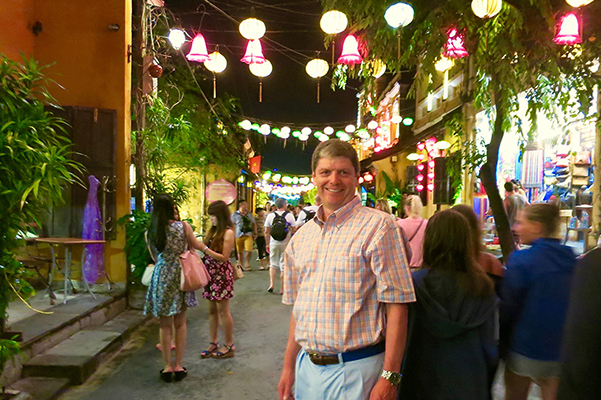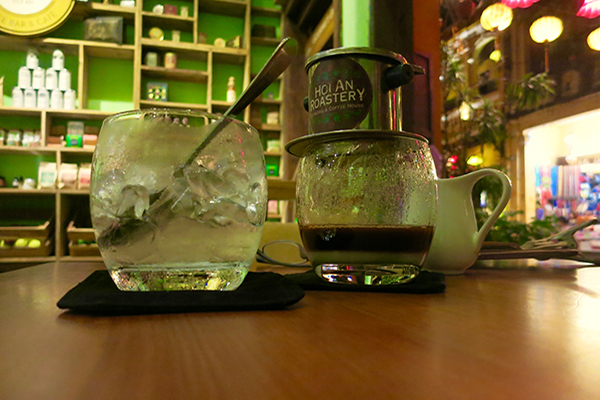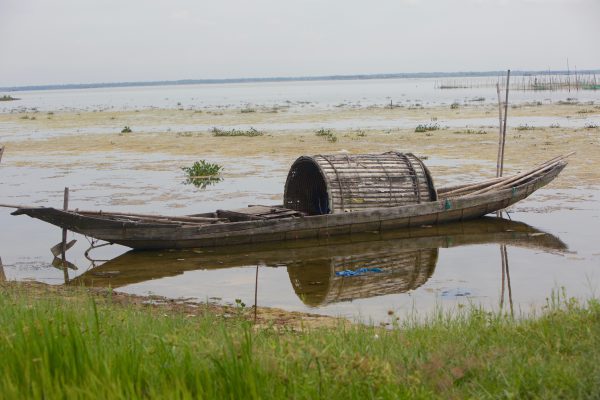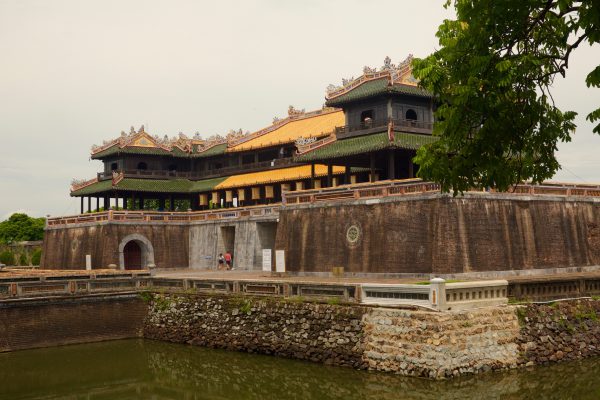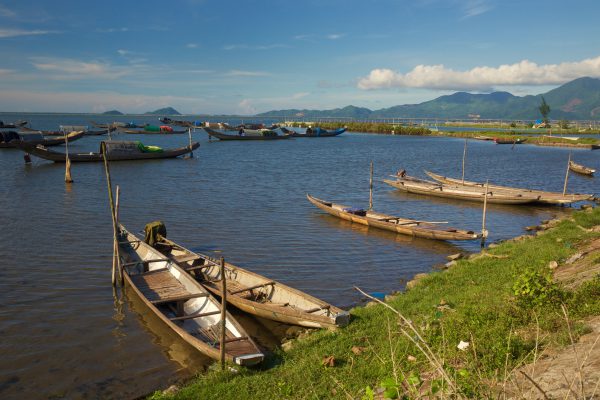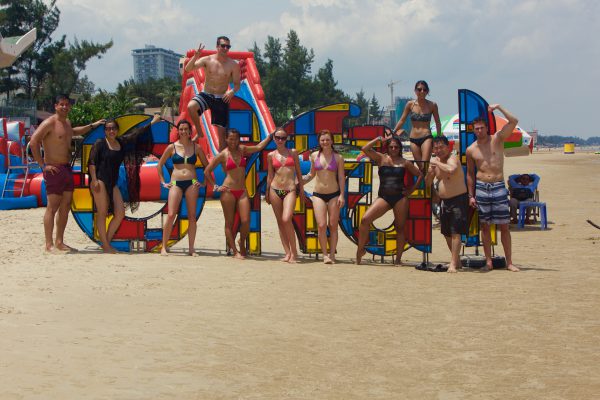We’d been trying to leave Ho Chi Minh City for Beijing for two days. While everyone in the U.S. had been focused on Hurricane Harvey in Texas, we’d been dealing with similar effects from Typhoon Pakhar in China. All air and sea traffic had been brought to a standstill while the storm passed over Hong Kong, Shenzhen, Guangdong and Guangzhou.
During travel things happen….and when you have 26 people in your party it can get even more complicated, as we would soon see. I don’t blame anybody for what happened, though I will say that some valuable lessons were learned – and lessons that were astonishingly apropos for a group studying disaster preparedness and dealing with disruption. We started moving at 11:00 a.m. and would not make it to the hotel in Beijing until well after 4:00 a.m. Then, two hours later, we would climb aboard the bullet train for a trip to my work alma mater at Honeywell in Tianjin. Guess there’s no rest for the weary. I’ll write more on business in Vietnam later, but I wanted to catch up with you now on my first impressions after two weeks of being a tourist and student.
From the time that I arrived I’ve found Vietnam a beautiful country. The people are friendly and incredibly welcoming. The culture is very different from anything I’ve experienced in the past. As a businessman I’ve learned that westerners cannot simply expect to have our values readily adopted and accepted by this culture. I’m not drawing good or bad conclusions from this: just stating that pushing the beliefs of Portland, London or Heidelberg will not necessarily work in Ho Chi Minh City. One needs to take the time to understand the people, history and culture in order to be successful in business here.
As a tourist, I’ve enjoyed visiting Ho Chi Minh City, Hue, Da Nang and Hoi An. I found My Son (an ancient spiritual capital) just as fascinating as going to sites in Greece or Rome. The food in Hoi An can rival the best anywhere in the world – it was truly amazingly delicious. I’ve never eaten anything as wonderful as a banana flower salad (and I don’t even like bananas).
As much as I tried my best to stay away from the war, the stories were everywhere. Discussions of the war’s impacts were a constant, from Tet in ’68 in Hue, to the use of dioxins on the landscape and what that’s done to the people today, to the reunification in 1975. The war has been over for more than 40 years now, but Vietnam is a country that was born and raised with wars – they make up most of its history. The people have learned to forgive, to accept, and to move ahead. Amazingly, they accepted me as an American and — while the stories are openly discussed — apparently they don’t hold the war against us today.
As for my students’ experience, we traveled to 11 different sites all over Ho Chi Minh City. We went from a purely manual factory to the most state-of-the-art, world-class manufacturing operation. Somehow, after visiting one of DHL’s sites, I avoided being detected as being on their Terrorist Watch List – LOL. It was funny … I could have given their presentation chapter and verse, having heard it so many times before.
There were a couple of things that stuck out to me:
- The absence of many U.S. companies. Yes, of course, Nike was there in a big way. But many of the traditional companies were missing. For instance, while construction was booming, there was no Caterpillar. The equipment was all Japanese. I also didn’t see any evidence of my former employers – neither John Deere nor Honeywell were present. It appears that we Americans are completely missing in this young and vibrant market.
- Vietnam reminds me a lot of China 20+ years ago. The workforce is very trainable but there is no local middle management. From all that I saw, upper and middle management personnel are expats from Taiwan, Japan, Korea and even Germany. Yes, the younger generation whose parents and grandparents left in the 50s, 60s and 70s are returning, but the skillsets to take this pulsing economy to the next level are missing. Areas such as HS&E, S&OP and basic Supply Chain Operations and Finance have not yet been built as core processes. This, in turn, leads to very uneven results as businesses attempt to grow.
Typhoon Pakhar and Contingency Planning
I teach Business Continuity Planning as part of my Corporate Training Portfolio.
Resiliency is the capacity to recover quickly from difficulties and to spring back into shape. Regardless of the type of interruption that is encountered, business continuity demands that managers protect the brand and company by resuming “normal” operations as quickly as possible, with a minimum amount of disruption to the company.
All too often, companies do not have the time or resources to foresee the impact that a disruption might have on their business. They wait until an event or disturbance occurs, then reactively manage the situation. This lack of preparation can turn what could have been a small disruption into a full-fledged crisis.
It’s funny, we had to live out every part of my lectures on this subject. A little background first to give some context. Twenty six of us from Portland State University left the hotel bound for Beijing bright and early Sunday morning at 0730. It had been a great two weeks in Vietnam, but it was the time to move to China for the final leg of our journey. We got through immigration and security quickly and in a relatively pain free manner.
Then came our first look at the departure monitors with the infamous word “Delayed.” First, the delay was 2 hours, then it grew to 4. My traveling partner (and faculty leader for the trip) Daniel Wong began to reach out to our travel agency, with the only problem being that it was the middle of the night back in the U.S. and the typhoon had created chaotic conditions in Hong Kong.
Complicating matters further was the fact that the airline had pulled all their gate agents out, so there was no one to talk to and accurate information was very hard to obtain. Another problem was that our visas had been terminated in Vietnam, so we couldn’t go back, and all of our luggage had been checked and was sitting on the tarmac in front of us. We told the students that we would get back to them by 11:00 with updated information, but by that time we still had nothing to tell them.
It became a classic case of disaster preparedness and response: what do you do with 26 people stranded in Ho Chi Minh City with no options?
Daniel quickly sprang into action and got us organized. He worked the HCMC piece with our ground crew to see if they could get our rooms back at the hotel. Meanwhile, one of the students, Michael Bayless, worked with airport security and immigration to see if he could find us a path out of the airport. I began to work on what our options in Hong Kong would be if we were able to make it out of Vietnam – after all, the typhoon had just made landfall there.
As it turned out, most of the hotels were booked but I did manage to find availability for a hotel in Kowloon. My issue then became how to get 26 people safely to Kowloon in the middle of a typhoon. I quickly found there was no way to accomplish this feat, so that meant that if we made it out, we were sleeping at the airport. This was not a good option for anyone, so Hong Kong was shifted to the least desirable option on our list. As we worked through the issues we knew that any one of us could get out on our own. The problem was that there were 26 of us.
Luckily, Daniel made contact with the airline agent in Hong Kong, who arranged for our bags to be taken off of the plane. Michael successfully found an English-speaking immigration officer, and my job (along with one of the students, Pedro Colon Amador) was to herd the 26 of us out of the airport to freedom. As the plan began to evolve it became clear that it was possible for us to actually leave the airport safely and return to the hotel, all together.
Daniel operated as a classic leader, implementing a business contingency plan:
The fundamental role of a business leader is to support their team by providing time, money and manpower, but beyond that the leader’s job is also to provide the cover needed for the team to remedy the crisis. Specifically this means:
- Distributing accurate information as quickly as possible
- Responding to incorrect information in a timely manner
- Triggering appropriate processes to keep employees, the public and shareholders informed on an ongoing basis
He kept his cool most of the time and only got upset with the airline when they were not providing us the necessary information in order for us to make proper decisions. In the end we made it safely back and all was good. My hat is off to this group – several stepped up to help lead and we stood together as a unit, following the leader’s instructions. We were rewarded by another great evening and day in Vietnam.
Supplier Loyalty In Action
One last area I’d like to touch on is about supplier loyalty. Throughout this exercise we had a partner that provided us the boots on the ground and an in country lead for us. We were 8000 miles from home, in a very different place, and this company made sure that the hotel accommodations were correct and that we got to all our appointments. They learned the various needs of the 26 of us and were there at all times: believe me, this was no small feat. As our problem unfolded the airline began to offer us accommodations at a higher-end hotel, yet Daniel made the decision to stay with the company that had helped us at every step along the way.
This is a key point in any business continuity effort – if you treat your suppliers well in times that are good, they will be there for you when bad times come and you really need them.
What’s Next?
Now we just need to follow up on our return for Lessons Learned so the university can build standardized work for contingency planning next year’s Travel Abroad cohort.
We moved on to China. This would be my first time here in three years. I was excited to see how the processes we worked so hard to implement had matured. I had a great team back then, so I was ready to see how they’d carried themselves forward.


